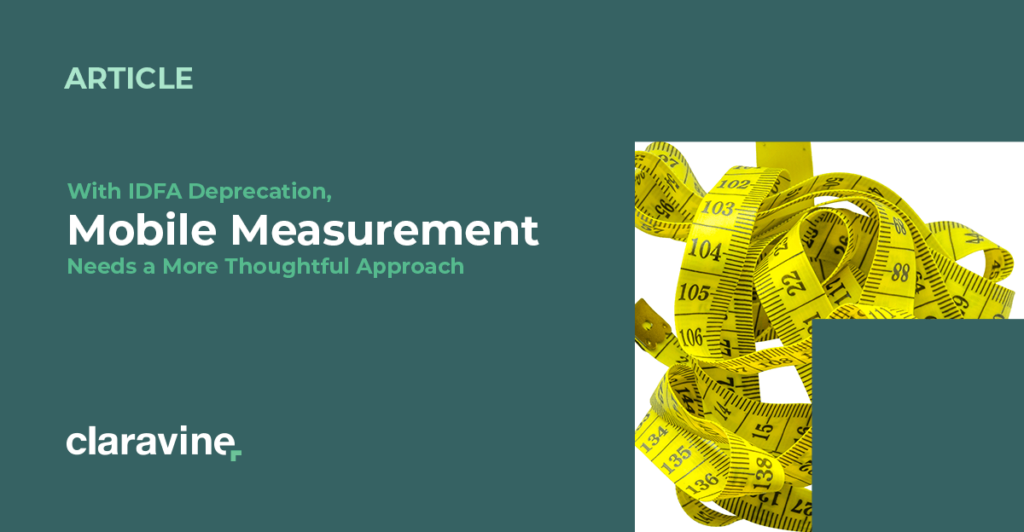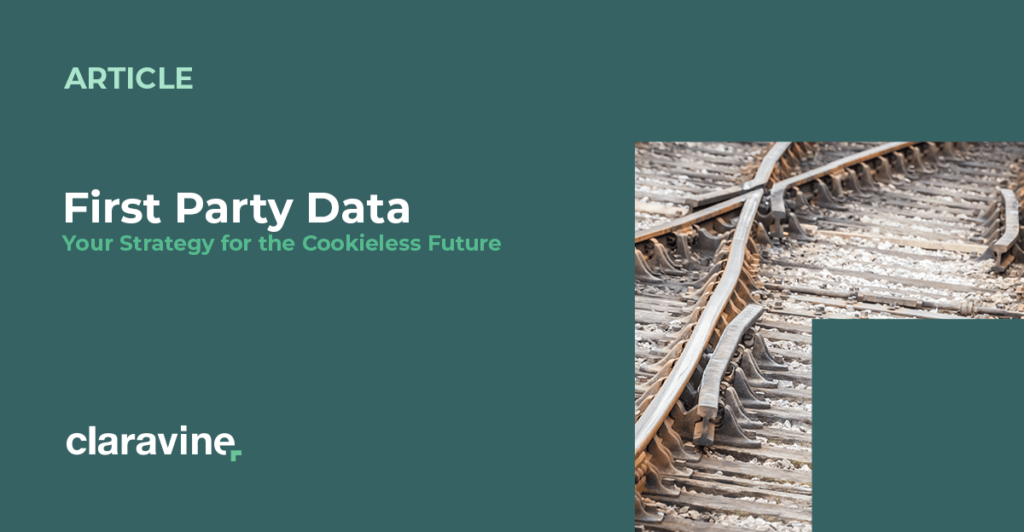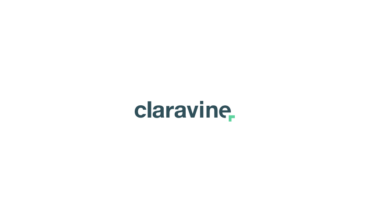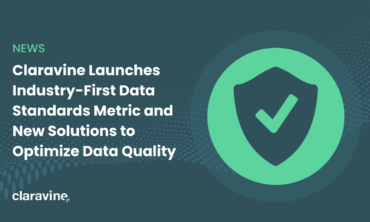Here’s How Post-IDFA Mobile Measurement for Marketers Looks in 2022

Headlines will have you believe the sky is falling, but allowing iOS users to opt-in or out of data tracking will not, actually, cause the mobile marketing ecosystem to crumble.
Confusions abound and learning curves are inevitable, but IDFA deprecation is the wake-up call many organizations need. Effective measurement and attribution require thoughtful, aggregated measurement strategies — and there is no time to waste in developing them.
In This Article
What’s Happening with Mobile Measurement as We Know It?
While App Tracking Transparency (ATT) — Apple’s updated privacy and data collection framework that requires mobile marketers to ask user permissions to track them across apps and websites — isn’t perfect, it does send a clear signal that a user’s data belongs to them.
Some industry experts challenge the effectiveness (ATT), noting that tracking is still happening, and app developers can still acquire anonymized, aggregated user data from other devices that effectively unmask a user’s identity. According to Apple’s website, Apple does not consider it tracking if the data cannot be used to identify the end-user or device.
How these dueling perspectives play out as Apple’s (and Google’s, etc.) policies mature is yet to be seen, but you don’t have to wait and see. You can take a proactive data management and measurement approach to shield from the next evolutions in tracking policy.
Regardless of how one defines tracking, the dominoes will continue to fall, meaning app developers and marketers will continue to lose visibility into an individual’s user behavior. Thus, organizations need data approaches that do not depend on any single type of ID.
Given mobile’s substantial role in the digital ecosystem, adopting these approaches is non-negotiable. Around 55% of all website views in January 2021 came from mobile devices. The average U.S. consumer spends more time using apps than watching TV. The mobile advertising ecosystem is simply too big, and too important, to not “work.”
But we don’t have to be creepy-level personalized (read: tracking individual identifiers and PII) to be effective. Nor do we need such granular, privacy-busting data to understand customer behavior, campaign results, and other important measurements and attributions.
IDFA depreciation could be an accelerant for wider adoption of more sustainable, combined measurement approaches and inspire organizations to develop strategies that are no longer focused on the individual, but rather on cohorts that respect privacy and anonymity while still enabling personalization.
Post-IDFA Deprecation Marketing Measurement and Attribution Methods
Effective measurement and attribution models already exist and will continue to improve as advertisers and vendors adjust to the new world of IDFA deprecation. But even those tactics which are bulletproof today can’t ever be relied on as a long-term solution — that’s just the nature of web advertising and the evolution of users’ trust in it.

An organization’s “safest” approach is to take control of its data. That means developing measurement, attribution, and campaign optimization tactics that are not dependent on Apple, Google, or Facebook, but rather varied and interconnected. This doesn’t mean abandoning the old ways of doing things completely (as you’ll see below, there’s still a place for them), but of taking a more thoughtful approach to how and from where your company gets its data.
Future-ready marketers and measurers will embrace multiple strategies and bridge them together in ways that squeeze more value from every piece of data to build multi-faceted measurement profiles.
The most reliable marketing measurement and attribution methods in the marketing and advertising world beyond IDFA deprecation include the following.
Apple’s ATT-compliant attribution method, SKAdNetwork (SKAN)
According to data from Liftoff, 70.5% of ad inventory is SKAdNetwork-compatible as of December 18, 2021.
SKAN aims to measure app installs and campaign performance without compromising user privacy. According to the industry’s first SKAN ranking, TikTok for Business is the highest-performing app on the network, followed by Facebook. The social media leader is still navigating change and expects performance to improve.
To prepare for SKAN, companies must identify new campaign goals and conversion values and check in with demand partners to ensure they are able to bid and report on SKAN-compatible inventory.
Advanced probabilistic modeling based on privacy-safe, aggregated data
Unlike deterministic models that depend on 1:1, user-level data, probabilistic models leverage anonymized data at scale. Techniques like media mix modeling (yes, the same approach leveraged by television broadcasters) can be used to estimate mobile campaign performance in an aggregated manner to protect user privacy while empowering marketers with enough information to make smart optimization and campaign spend decisions.
One promising area of innovation is incrementality, which allows advertisers to measure and optimize the incremental lift from remarketing campaigns and adjust campaign spend accordingly, using test and control groups to control for variables and confirm assumptions.
Effective execution, though, requires sufficient data sets and ironclad processes. An incrementality solution from AppsFlyer addresses some of these pain points and offers advanced insights into remarketing campaign effectiveness.
User-level deterministic attribution
More users than expected have opted into Apple’s ATT. According to AppsFlyer data, 38% of U.S. users and 46% of global users who saw the prompt opted in. IDFA audiences are still small, though, in part because 55% of app owners have not deployed the prompt. App owners may worry the prompt’s message will be off-putting and cause churn.
For devices with an IDFA, as well as Android devices which comprise 45.9% of the mobile operating system market in North America, using unique identifiers is still an option. By stitching together device IDs and customer identifiers, such as anonymized log-in data or email addresses, advertisers can identify users and attribute clicks, installs, and other in-app activity.
Marketers should not bank on this strategy for much longer, though — measurement solutions must be flexible enough to adapt to a mobile ecosystem that will likely continue to prioritize user privacy.
Creating a Data Taxonomy to Improve Mobile Attribution and Privacy-Adherent Measurement
It starts from within.
Whether it’s new legislation, another Google or Apple update, or evolving customer preferences, more change is inevitable. To adapt quickly, organizations need agile, flexible processes and cultures. A foundational step is creating a data taxonomy — a framework for all of your data, no matter how it’s collected.
This will enable your enterprise to define and manage data across regions, teams, and use cases, so you can effectively collect and leverage first-party data while making reliable, trustworthy end-to-end measurements.

According to recent research from Claravine, reliance on first-party data is the biggest driver of change for attribution models. By creating more accurate, high-quality inputs for analytics and attribution systems, you will gain a clearer picture of marketing performance and discover new opportunities for improvement.
Getting mobile attribution right isn’t a pipedream. The same study found that many advertisers are confident they can navigate privacy changes, or at least they are not despondent: just 30% of advertisers believe the end of device-level IDs will negatively impact the business, while 37% think it will have a positive impact.
 Optimistic marketers may reason changes in IDFA will strengthen their brand by hurting competitors who rely heavily on retargeting while rewarding those that harness first-party data. They may also believe pro-privacy updates will bolster user confidence in mobile and digital advertising.
Optimistic marketers may reason changes in IDFA will strengthen their brand by hurting competitors who rely heavily on retargeting while rewarding those that harness first-party data. They may also believe pro-privacy updates will bolster user confidence in mobile and digital advertising.
Wise marketing leaders look to their data taxonomy and their marketing data standards tool to define, connect, and control data flowing in from thousands of employees, hundreds of SaaS apps, and millions of customers. This allows their teams to build robust cohort profiles informed by data and metadata from marketing, sales, analytics, CX, ecommerce, and other tools collecting and creating first-party data.

Keeping pace with pro-privacy changes and piecing attribution models together is challenging, certainly. But it is not all doom and gloom. With the right tools, data frameworks, and partners, advertisers can run effective and measurable marketing campaigns in a privacy-first world.


